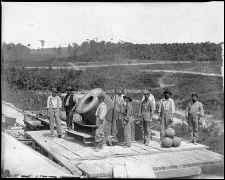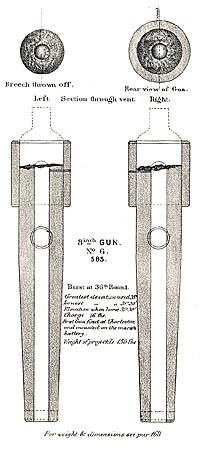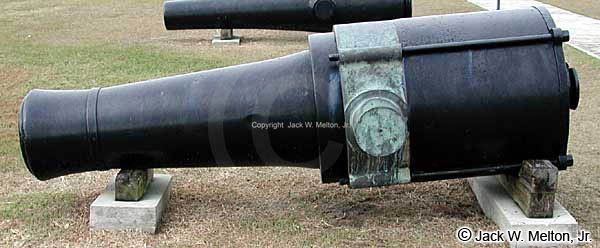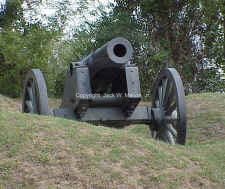Famous Cannon & Mortars
Dictator - 13-inch Mortar
Perhaps the most famous mortar used during the war was the "Dictator." This weapon was a 13-inch Model
1861 seacoast mortar which was mounted on a specially reinforced railroad car to
accommodate its weight of 17,000 pounds. Company G of the 1st Connecticut Heavy Artillery,
served the "Dictator" at the siege of Petersburg,
Virginia in 1864. The mortar could lob a 200-pound explosive shell about 2 ½ miles. The
"Dictator" was usually positioned in a
curved section of the Petersburg & City Point Railroad and was employed for about
three months during the siege.
reinforced railroad car to
accommodate its weight of 17,000 pounds. Company G of the 1st Connecticut Heavy Artillery,
served the "Dictator" at the siege of Petersburg,
Virginia in 1864. The mortar could lob a 200-pound explosive shell about 2 ½ miles. The
"Dictator" was usually positioned in a
curved section of the Petersburg & City Point Railroad and was employed for about
three months during the siege.
Swamp Angel - 200-pounder Parrott Rifle
In preparation for the bombardment of Charleston, South Carolina, in August, 1863, Major General Quincy Gillmore ordered the construction of
a battery in the swampy marsh near Morris
Island. An 8-inch, 200-pounder Parrott siege gun was
mounted, under fire from the Confederates, and promptly began firing incendiary shells
into the city. This gun, named the "Swamp
Angel" continued firing for two days until, on the thirty-sixth round, the gun
exploded. But, it had caused a tremendous amount of moral damage in Charleston and went
into history as the most famous Parrott gun. The
"Swamp Angel" cannon is now located in Trenton, NJ.
An 8-inch, 200-pounder Parrott siege gun was
mounted, under fire from the Confederates, and promptly began firing incendiary shells
into the city. This gun, named the "Swamp
Angel" continued firing for two days until, on the thirty-sixth round, the gun
exploded. But, it had caused a tremendous amount of moral damage in Charleston and went
into history as the most famous Parrott gun. The
"Swamp Angel" cannon is now located in Trenton, NJ.
Confederate 7-inch caliber Brooke rifled cannon, triple
banded

Charleston, S.C. Mounted gun, parapet of Fort Moultrie
CREATED/PUBLISHED
1865.
SUMMARY
Photographs of the Federal Navy, and seaborne expeditions against the
Atlantic Coast of the Confederacy, specifically of Charleston, S.C.,
1863-1865.
NOTES
Civil War photographs, 1861-1865 / compiled by Hirst D. Milhollen and
Donald H. Mugridge, Washington, D.C. : Library of Congress, 1977. No. 0621
Forms part of Selected Civil War photographs, 1861-1865 (Library of Congress)
Modern photographs taken at Fort Moultrie in 2001.
10-inch Columbia smoothbore, rifled and banded by J. M. Eason Brothers

J. M. Eason Bros.: Charleston firm operated by J. M. and T. D. Eason. James M. Eason, proprietor. Soon after the capture of Fort Sumter the Eason firm prepared machinery and began rifling a 24-pounder smoothbore for the State of South Carolina. Subsequently, a portable rifling machine was made which could rifle guns at various distant locations. The Charleston Mercury of July 20, 1861, reported that "... it has been demonstrated that the Eason gun will throw solid shot or shell, with accuracy, further than any other cannon now in our possession." By September over twenty heavy guns were at the shop awaiting rifling operations. (Columbus Times, September 9, 1861) In November, 1862, Major Childs at the Charleston Arsenal reported that "full three weeks have heretofore been taken by Messrs. Eason Brother in rifling and banding 32-pounder and 42-pounder guns; but that by working at night and on Sundays and distributing the work between Eason and Cameron I hope to be able to finish one gun per week." (O.R.., XIV, 690) General Beauregard, on his own initiative and without Richmond's approval, later had several Columbiads rifled by Eason. This embroiled him in a controversy with the War Department and initially payment on the bill was refused. Rifling of Columbiads had not proven successful in the past but Eason also banded the guns which made them considerably safer. Under growing political pressure, the War Department backed down and the bills were paid. Two 10-inch Columbiads rifled by Eason survive at Charleston. The one shown is located at Fort Moultrie, S.C. and was used in Battery Bee on Sullivan's Island.
Widow Blakely - 7.5-inch Blakely Rifle
"The Widow Blakely" was located about 1 mile
north of its current position during the Siege of Vicksburg, Mississippi. It
was misidentified as a 7.44-inch caliber rifle but inside micrometer measurements of the
lands, nearly 1.5 inches wide, show diameters between 7.50 and 7.51 inches.
It
was misidentified as a 7.44-inch caliber rifle but inside micrometer measurements of the
lands, nearly 1.5 inches wide, show diameters between 7.50 and 7.51 inches.
On May 22, 1863, one of "The Widow Blakely's" shells exploded in the tube while it was firing at a Union gunboat. The explosion took part of the end of the muzzle off, leaving the remainder of the tube intact. The ragged ends were cut smooth and the rifle was used as a mortar during the rest of the siege (Pemberton surrendered to Grant on July 4, 1863). It is rifled with 12 lands and grooves in the typical hook-slant Blakely fashion. After the trimming of the muzzle the overall length is about 100 inches. Originally the tube would have been about 124 inches long. It was taken to West Point Military Academy as a war trophy and remained there for ninety-six years until its return to Vicksburg.
Actual reports from the Official Records listing "The Widow Blakely" can be found by clicking here.
Additional photographs of "The Widow Blakely"










